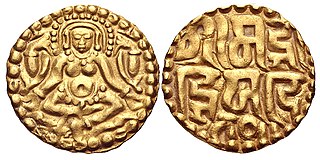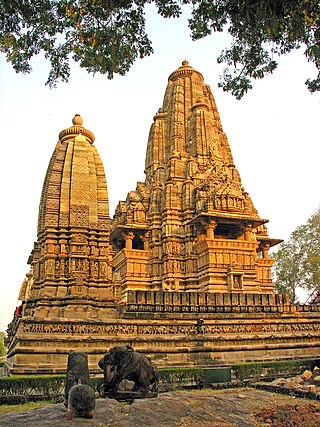
The Gurjara-Pratihara was a dynasty that ruled much of Northern India from the mid-8th to the 11th century. They ruled first at Ujjain and later at Kannauj.

The Chandelas of Jejakabhukti was an Indian dynasty in Central India. The Chandelas ruled much of the Bundelkhand region between the 9th and the 13th centuries. They belonged to the Chandel clan of the Rajputs.
Nannuka was the founder of the Chandela dynasty of India. He ruled in the Jejakabhukti region.
Ganda was an early 11th century king of the Chandela dynasty of India. He ruled in the Jejakabhukti region. The exact period of his reign is uncertain, but has been dated approximately as 999-1002 CE.
Dhanga, also known as Dhaṇgadeva in inscriptions, was a king of the Chandela dynasty of India. He ruled in the Jejakabhukti region. Dhanga established the sovereignty of the Chandelas, who had served as vassals to the Pratiharas until his reign. He is also notable for having commissioned magnificent temples at Khajuraho, including the Vishvanatha temple.
Jayashakti was a 9th-century ruler from the Chandela dynasty of Central India. In the Chandela records, he is generally mentioned with his younger brother and successor, Vijayashakti. The two are believed to have ruled the Chandela kingdom between c. 865 and 885 CE. They consolidated the Chandela power.
Rahila was a king of the Chandela dynasty of India. He ruled in the Jejakabhukti region.

The Kalachuris of Tripuri, also known the Kalachuris of Chedi, ruled parts of central India during 7th to 13th centuries. They are also known as the Later Kalachuris to distinguish them from their earlier namesakes, especially the Kalachuris of Mahishmati. Their core territory included the historical Chedi region, and their capital was located at Tripuri.

The 11th century Paramara king Bhoja ruled from his capital at Dhara. The period of his reign is dated approximately 1010 CE to 1055 CE, although some historians believe that he ascended the throne before 1010 CE. Bhoja inherited a kingdom centered around the Malwa region, and made several attempts to expand it varying results. He managed to annex territories as far as northern parts of Konkan, but these territorial gains were short-lived. He fought wars against several of his neighbours, including the Chaulukyas of Gujarat, the Chalukyas of Lata, the Chalukyas of Kalyani, the Chandelas of Jejakabhukti, the Kachchhapaghatas of Gwalior, the Chahamanas of Shakambhari, the Chahamanas of Naddula, and the Kalachuris of Tripuri. He also conflicted with Gaznavid Turk Invaders, Mahmud's desecration of the Somnath temple in Gujarat motivated Bhoja to lead an army against him, however after Somnath raid, Mahmud Gazhnavi chose a more dangerous route via Sindh, to avoid facing the invading powerful armies of Bhoja.
Harsha, also known as Shri Harsha, was a king of the Chandela dynasty of India. He ruled in the Jejakabhukti region.

Yashovarman, also known as Lakshavarman, was a king of the Chandela dynasty of India. He ruled in the Jejakabhukti region. He practically established the Chandelas as a sovereign power, although he formally acknowledged suzerainty of the Gurjara-Pratiharas. His major military achievement was the conquest of Kalanjara. He is also notable for having commissioned the Lakshmana Temple at Khajuraho.
Vijayapala was a king of the Chandela dynasty of India. He ruled in the Jejakabhukti region.
Kirttivarman, also known as Kīrtivarman, was a king of the Chandela dynasty of India. He ruled the Jejakabhukti region. He revived the Chandela power by defeating the Kalachuri king Lakshmi-Karna.

Sallakshana-Varman was a king of the Chandela dynasty of India. He succeeded his father Kirttivarman as the ruler of the Jejakabhukti region. The inscriptions of his descendants suggest that he achieved military successes against the Paramaras, the Kalachuris of Tripuri and the ruler of Kanyakubja.
Jayavarman was a king of the Chandela dynasty of India. He succeeded his father Sallakshana-Varman as the ruler of the Jejakabhukti region. The Chandela descriptions contain only vague eulogies of him, so little historical information is known about his reign. He abdicated the throne in favour of his uncle Prithvi-Varman.

Madana-Varman was a king of the Chandela dynasty of India. He succeeded his father Prithvi-Varman as the ruler of the Jejakabhukti region. He revived the Chandela glory by subduing the neighbouring kingdoms, and commissioned several tanks and temples.
Paramardi was a king of the Chandela dynasty of central India. He was the last powerful Chandela king, and ruled the Jejakabhukti region. Around 1182–83 CE, he was defeated by Prithviraj Chauhan, who raided the Chandela capital Mahoba. Paramardi managed to recover the Chandela power over the next few years, but was defeated by the Ghurid general Qutb ud-Din Aibak around 1202–03 CE.
Vira-Varman was a king of the Chandela dynasty of central India. He ruled the Jejakabhukti region.

Gangeyadeva was a ruler of the Kalachuri dynasty of Tripuri in central India. His kingdom was centered around the Chedi or Dahala region in present-day Madhya Pradesh.

The Ghaznavid invasion of Kannauj or the siege of Kannauj in 1018 was a military campaign conducted by Mahmud of Ghazni, the then ruler of the Ghaznavid Empire, against the Gurjara-Pratihara dynasty. During this siege, the Gurjar ruler, Rajyapala, eventually surrendered to Mahmud of Ghazni, thereby accepting nominal suzerainty under his rule. This event marked the decline of the Gurjara dynasty's power. In the aftermath of his surrender to Mahmud, Rajyapala met his demise at the hands of the Chandela ruler, Vidhyadara, for capitulating to the Ghaznavid conqueror.







